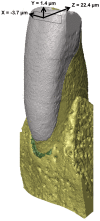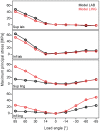The adaptive significance of enamel loss in the mandibular incisors of cercopithecine primates (Mammalia: Cercopithecidae): a finite element modelling study
- PMID: 24831704
- PMCID: PMC4022739
- DOI: 10.1371/journal.pone.0097677
The adaptive significance of enamel loss in the mandibular incisors of cercopithecine primates (Mammalia: Cercopithecidae): a finite element modelling study
Abstract
In several primate groups enamel is reduced or absent from the lingual (tongue) side of the mandibular incisor crowns akin to other placental and marsupial mammalian groups such as rodents, lagomorphs and wombats. Here we investigate the presumed adaptation of crowns with unilateral enamel to the incision of tough foods in cercopithecines, an Old World monkey subfamily, using a simulation approach. We developed and validated a finite element model of the lower central incisor of the rhesus macaque (Macaca mulatta) with labial enamel only to compute three-dimensional displacements and maximum principal stresses on the crown subjected to compressive loads varying in orientation. Moreover, we developed a model of a macaque incisor with enamel present on both labial and lingual aspects, thus resembling the ancestral condition found in the sister taxon, the leaf-eating colobines. The results showed that, concomitant with experimental results, the cercopithecine crown with unilateral enamel bends predominantly towards the inside of the mouth, while displacements decreased when both labial and lingual enamel are present. Importantly, the cercopithecine incisor crown experienced lower maximum principal stress on the lingual side compared to the incisor with enamel on the lingual and labial aspects under non-axial loads directed either towards the inside or outside of the mouth. These findings suggest that cercopithecine mandibular incisors are adapted to a wide range of ingestive behaviours compared to colobines. We conclude that the evolutionary loss of lingual enamel in cercopithecines has conferred a safeguard against crown failure under a loading regime assumed for the ingestion (peeling, scraping) of tough-skinned fruits.
Conflict of interest statement
Figures






Similar articles
-
Distribution of enamel on the incisors of Old World monkeys.Am J Phys Anthropol. 1986 Sep;71(1):103-13. doi: 10.1002/ajpa.1330710113. Am J Phys Anthropol. 1986. PMID: 3777142
-
Structure-function relations of primate lower incisors: a study of the deformation of Macaca mulatta dentition using electronic speckle pattern interferometry (ESPI).J Anat. 2011 Jan;218(1):87-95. doi: 10.1111/j.1469-7580.2010.01234.x. J Anat. 2011. PMID: 20408905 Free PMC article.
-
Three-dimensional finite-element analysis of a central lower incisor under labial and lingual loads.Prog Orthod. 2012 Sep;13(2):154-63. doi: 10.1016/j.pio.2011.10.005. Epub 2012 Mar 7. Prog Orthod. 2012. PMID: 23021119
-
Torque control of the maxillary incisors in lingual and labial orthodontics: a 3-dimensional finite element analysis.Am J Orthod Dentofacial Orthop. 2009 Mar;135(3):316-22. doi: 10.1016/j.ajodo.2007.03.039. Am J Orthod Dentofacial Orthop. 2009. PMID: 19268829
-
Presence of enamel on the incisors of the llama (Lama glama) and alpaca (Lama pacos).Anat Rec. 1997 Dec;249(4):441-8. doi: 10.1002/(SICI)1097-0185(199712)249:4<441::AID-AR3>3.0.CO;2-U. Anat Rec. 1997. PMID: 9415451
Cited by
-
Food mechanical properties and isotopic signatures in forest versus savannah dwelling eastern chimpanzees.Commun Biol. 2018 Aug 10;1:109. doi: 10.1038/s42003-018-0115-6. eCollection 2018. Commun Biol. 2018. PMID: 30271989 Free PMC article.
-
Shape Optimization for Additive Manufacturing of Removable Partial Dentures--A New Paradigm for Prosthetic CAD/CAM.PLoS One. 2015 Jul 10;10(7):e0132552. doi: 10.1371/journal.pone.0132552. eCollection 2015. PLoS One. 2015. PMID: 26161878 Free PMC article.
-
3D enamel thickness in Neandertal and modern human permanent canines.J Hum Evol. 2017 Dec;113:162-172. doi: 10.1016/j.jhevol.2017.08.009. Epub 2017 Sep 21. J Hum Evol. 2017. PMID: 29054166 Free PMC article.
-
Dynamic Modelling of Tooth Deformation Using Occlusal Kinematics and Finite Element Analysis.PLoS One. 2016 Mar 31;11(3):e0152663. doi: 10.1371/journal.pone.0152663. eCollection 2016. PLoS One. 2016. PMID: 27031836 Free PMC article.
References
-
- Barak MM, Geiger S, Chattah NL, Shahar R, Weiner S (2009) Enamel dictates whole tooth deformation: a finite element model study validated by a metrology method. J Struct Biol 168: 511–520. - PubMed
Publication types
MeSH terms
LinkOut - more resources
Full Text Sources
Other Literature Sources

